Banking Exams Exam > Banking Exams Questions > Study the following instructions and answer ...
Start Learning for Free
Study the following instructions and answer the questions that follow:
Ten persons J, K, L, M, N, P, Q, R, S, T are sitting around a rectangular table but not necessarily in the same order. Two people sit on each of the two longer sides of the table while one person sits on each of the two shorter sides of the table. One person sits at each of the four corners of the table. The persons sitting on the sides of the table face away from the centre while the persons sitting at the corners face towards the centre of the table.
Q faces R who sits to the immediate right of T. Two persons sit between R and S who faces the opposite direction of R. M sits to the immediate left of J. Either J or M is an immediate neighbour of R. No one sits between J and P. Q is not an immediate neighbour of L. The number of persons sitting between T and J when counted to the right of T is the same as the number of persons sitting between K and S when counted to the left of S.
Q. Which of the following statements are definitely true?
- a)S sits to the immediate right of L.
- b)Three persons sit between N and R.
- c)S sits to the immediate right of N.
- d)P sits exactly between K and J when counted to the left of K.
- e)More than one option
Correct answer is option 'E'. Can you explain this answer?
Most Upvoted Answer
Study the following instructions and answer the questions that follow...
Q faces R who sits to the immediate right of T.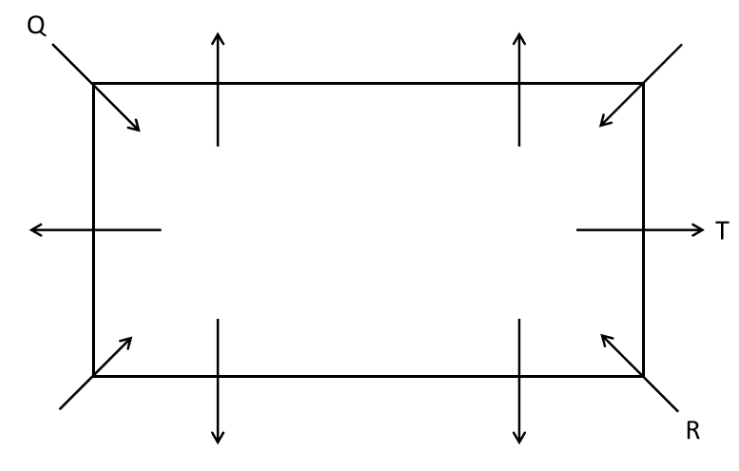
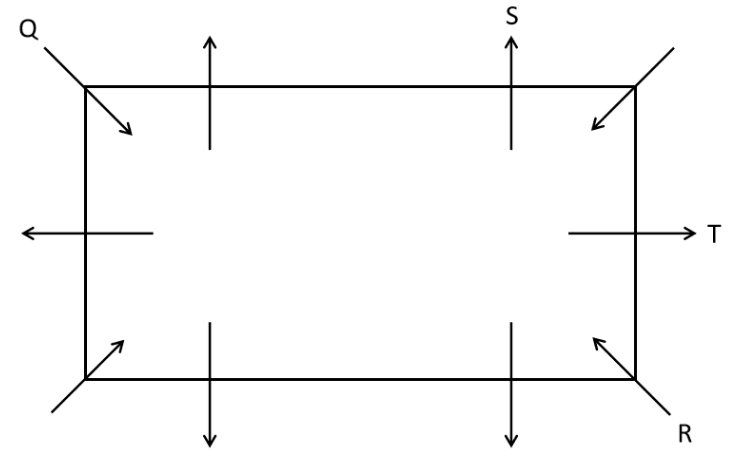
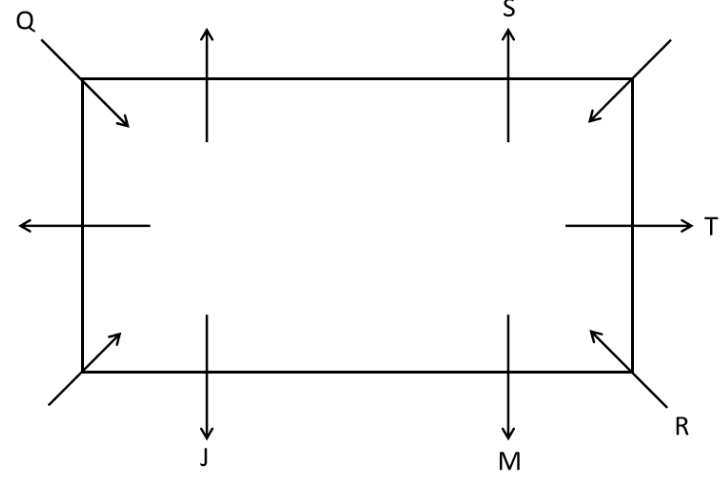
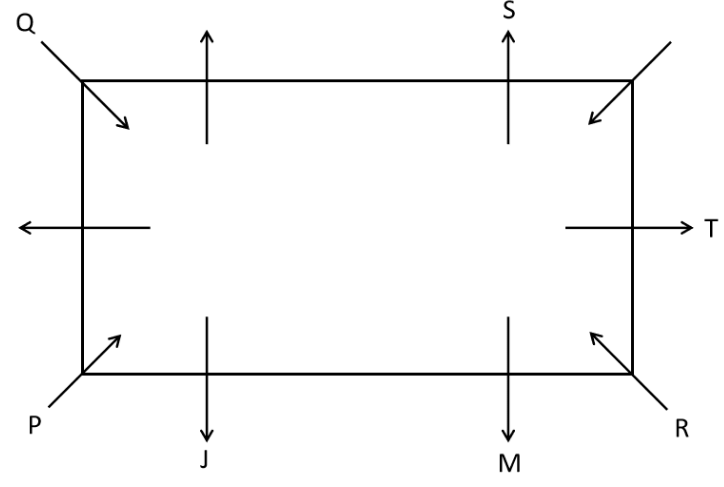
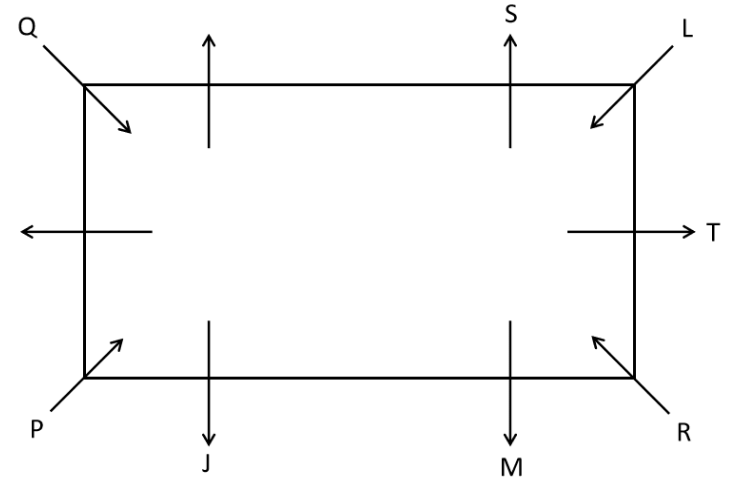
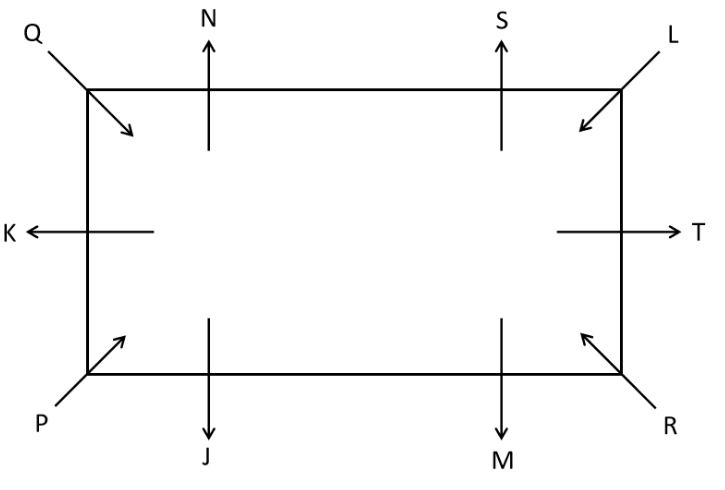

Two persons sit between R and S who faces the opposite direction of R.

M sits to the immediate left of J. Either J or M is an immediate neighbour of R.

No one sits between J and P.

Q is not an immediate neighbour of L.

The number of persons sitting between T and J when counted to the right of T is the same as the number of persons sitting between K and S when counted to the left of S.
The number of persons sitting between T and J is two,
Hence, the number of persons sitting between K and S when counted to the left of S will be two.
Only N is remaining.

All the statements given in the options are true.

|
Explore Courses for Banking Exams exam
|

|
Question Description
Study the following instructions and answer the questions that follow:Ten persons J, K, L, M, N, P, Q, R, S, T are sitting around a rectangular table but not necessarily in the same order. Two people sit on each of the two longer sides of the table while one person sits on each of the two shorter sides of the table. One person sits at each of the four corners of the table. The persons sitting on the sides of the table face away from the centre while the persons sitting at the corners face towards the centre of the table.Q faces R who sits to the immediate right of T. Two persons sit between R and S who faces the opposite direction of R. M sits to the immediate left of J. Either J or M is an immediate neighbour of R. No one sits between J and P. Q is not an immediate neighbour of L. The number of persons sitting between T and J when counted to the right of T is the same as the number of persons sitting between K and S when counted to the left of S.Q. Which of the following statements are definitely true?a)S sits to the immediate right of L.b)Three persons sit between N and R.c)S sits to the immediate right of N.d)P sits exactly between K and J when counted to the left of K.e)More than one optionCorrect answer is option 'E'. Can you explain this answer? for Banking Exams 2025 is part of Banking Exams preparation. The Question and answers have been prepared according to the Banking Exams exam syllabus. Information about Study the following instructions and answer the questions that follow:Ten persons J, K, L, M, N, P, Q, R, S, T are sitting around a rectangular table but not necessarily in the same order. Two people sit on each of the two longer sides of the table while one person sits on each of the two shorter sides of the table. One person sits at each of the four corners of the table. The persons sitting on the sides of the table face away from the centre while the persons sitting at the corners face towards the centre of the table.Q faces R who sits to the immediate right of T. Two persons sit between R and S who faces the opposite direction of R. M sits to the immediate left of J. Either J or M is an immediate neighbour of R. No one sits between J and P. Q is not an immediate neighbour of L. The number of persons sitting between T and J when counted to the right of T is the same as the number of persons sitting between K and S when counted to the left of S.Q. Which of the following statements are definitely true?a)S sits to the immediate right of L.b)Three persons sit between N and R.c)S sits to the immediate right of N.d)P sits exactly between K and J when counted to the left of K.e)More than one optionCorrect answer is option 'E'. Can you explain this answer? covers all topics & solutions for Banking Exams 2025 Exam. Find important definitions, questions, meanings, examples, exercises and tests below for Study the following instructions and answer the questions that follow:Ten persons J, K, L, M, N, P, Q, R, S, T are sitting around a rectangular table but not necessarily in the same order. Two people sit on each of the two longer sides of the table while one person sits on each of the two shorter sides of the table. One person sits at each of the four corners of the table. The persons sitting on the sides of the table face away from the centre while the persons sitting at the corners face towards the centre of the table.Q faces R who sits to the immediate right of T. Two persons sit between R and S who faces the opposite direction of R. M sits to the immediate left of J. Either J or M is an immediate neighbour of R. No one sits between J and P. Q is not an immediate neighbour of L. The number of persons sitting between T and J when counted to the right of T is the same as the number of persons sitting between K and S when counted to the left of S.Q. Which of the following statements are definitely true?a)S sits to the immediate right of L.b)Three persons sit between N and R.c)S sits to the immediate right of N.d)P sits exactly between K and J when counted to the left of K.e)More than one optionCorrect answer is option 'E'. Can you explain this answer?.
Study the following instructions and answer the questions that follow:Ten persons J, K, L, M, N, P, Q, R, S, T are sitting around a rectangular table but not necessarily in the same order. Two people sit on each of the two longer sides of the table while one person sits on each of the two shorter sides of the table. One person sits at each of the four corners of the table. The persons sitting on the sides of the table face away from the centre while the persons sitting at the corners face towards the centre of the table.Q faces R who sits to the immediate right of T. Two persons sit between R and S who faces the opposite direction of R. M sits to the immediate left of J. Either J or M is an immediate neighbour of R. No one sits between J and P. Q is not an immediate neighbour of L. The number of persons sitting between T and J when counted to the right of T is the same as the number of persons sitting between K and S when counted to the left of S.Q. Which of the following statements are definitely true?a)S sits to the immediate right of L.b)Three persons sit between N and R.c)S sits to the immediate right of N.d)P sits exactly between K and J when counted to the left of K.e)More than one optionCorrect answer is option 'E'. Can you explain this answer? for Banking Exams 2025 is part of Banking Exams preparation. The Question and answers have been prepared according to the Banking Exams exam syllabus. Information about Study the following instructions and answer the questions that follow:Ten persons J, K, L, M, N, P, Q, R, S, T are sitting around a rectangular table but not necessarily in the same order. Two people sit on each of the two longer sides of the table while one person sits on each of the two shorter sides of the table. One person sits at each of the four corners of the table. The persons sitting on the sides of the table face away from the centre while the persons sitting at the corners face towards the centre of the table.Q faces R who sits to the immediate right of T. Two persons sit between R and S who faces the opposite direction of R. M sits to the immediate left of J. Either J or M is an immediate neighbour of R. No one sits between J and P. Q is not an immediate neighbour of L. The number of persons sitting between T and J when counted to the right of T is the same as the number of persons sitting between K and S when counted to the left of S.Q. Which of the following statements are definitely true?a)S sits to the immediate right of L.b)Three persons sit between N and R.c)S sits to the immediate right of N.d)P sits exactly between K and J when counted to the left of K.e)More than one optionCorrect answer is option 'E'. Can you explain this answer? covers all topics & solutions for Banking Exams 2025 Exam. Find important definitions, questions, meanings, examples, exercises and tests below for Study the following instructions and answer the questions that follow:Ten persons J, K, L, M, N, P, Q, R, S, T are sitting around a rectangular table but not necessarily in the same order. Two people sit on each of the two longer sides of the table while one person sits on each of the two shorter sides of the table. One person sits at each of the four corners of the table. The persons sitting on the sides of the table face away from the centre while the persons sitting at the corners face towards the centre of the table.Q faces R who sits to the immediate right of T. Two persons sit between R and S who faces the opposite direction of R. M sits to the immediate left of J. Either J or M is an immediate neighbour of R. No one sits between J and P. Q is not an immediate neighbour of L. The number of persons sitting between T and J when counted to the right of T is the same as the number of persons sitting between K and S when counted to the left of S.Q. Which of the following statements are definitely true?a)S sits to the immediate right of L.b)Three persons sit between N and R.c)S sits to the immediate right of N.d)P sits exactly between K and J when counted to the left of K.e)More than one optionCorrect answer is option 'E'. Can you explain this answer?.
Solutions for Study the following instructions and answer the questions that follow:Ten persons J, K, L, M, N, P, Q, R, S, T are sitting around a rectangular table but not necessarily in the same order. Two people sit on each of the two longer sides of the table while one person sits on each of the two shorter sides of the table. One person sits at each of the four corners of the table. The persons sitting on the sides of the table face away from the centre while the persons sitting at the corners face towards the centre of the table.Q faces R who sits to the immediate right of T. Two persons sit between R and S who faces the opposite direction of R. M sits to the immediate left of J. Either J or M is an immediate neighbour of R. No one sits between J and P. Q is not an immediate neighbour of L. The number of persons sitting between T and J when counted to the right of T is the same as the number of persons sitting between K and S when counted to the left of S.Q. Which of the following statements are definitely true?a)S sits to the immediate right of L.b)Three persons sit between N and R.c)S sits to the immediate right of N.d)P sits exactly between K and J when counted to the left of K.e)More than one optionCorrect answer is option 'E'. Can you explain this answer? in English & in Hindi are available as part of our courses for Banking Exams.
Download more important topics, notes, lectures and mock test series for Banking Exams Exam by signing up for free.
Here you can find the meaning of Study the following instructions and answer the questions that follow:Ten persons J, K, L, M, N, P, Q, R, S, T are sitting around a rectangular table but not necessarily in the same order. Two people sit on each of the two longer sides of the table while one person sits on each of the two shorter sides of the table. One person sits at each of the four corners of the table. The persons sitting on the sides of the table face away from the centre while the persons sitting at the corners face towards the centre of the table.Q faces R who sits to the immediate right of T. Two persons sit between R and S who faces the opposite direction of R. M sits to the immediate left of J. Either J or M is an immediate neighbour of R. No one sits between J and P. Q is not an immediate neighbour of L. The number of persons sitting between T and J when counted to the right of T is the same as the number of persons sitting between K and S when counted to the left of S.Q. Which of the following statements are definitely true?a)S sits to the immediate right of L.b)Three persons sit between N and R.c)S sits to the immediate right of N.d)P sits exactly between K and J when counted to the left of K.e)More than one optionCorrect answer is option 'E'. Can you explain this answer? defined & explained in the simplest way possible. Besides giving the explanation of
Study the following instructions and answer the questions that follow:Ten persons J, K, L, M, N, P, Q, R, S, T are sitting around a rectangular table but not necessarily in the same order. Two people sit on each of the two longer sides of the table while one person sits on each of the two shorter sides of the table. One person sits at each of the four corners of the table. The persons sitting on the sides of the table face away from the centre while the persons sitting at the corners face towards the centre of the table.Q faces R who sits to the immediate right of T. Two persons sit between R and S who faces the opposite direction of R. M sits to the immediate left of J. Either J or M is an immediate neighbour of R. No one sits between J and P. Q is not an immediate neighbour of L. The number of persons sitting between T and J when counted to the right of T is the same as the number of persons sitting between K and S when counted to the left of S.Q. Which of the following statements are definitely true?a)S sits to the immediate right of L.b)Three persons sit between N and R.c)S sits to the immediate right of N.d)P sits exactly between K and J when counted to the left of K.e)More than one optionCorrect answer is option 'E'. Can you explain this answer?, a detailed solution for Study the following instructions and answer the questions that follow:Ten persons J, K, L, M, N, P, Q, R, S, T are sitting around a rectangular table but not necessarily in the same order. Two people sit on each of the two longer sides of the table while one person sits on each of the two shorter sides of the table. One person sits at each of the four corners of the table. The persons sitting on the sides of the table face away from the centre while the persons sitting at the corners face towards the centre of the table.Q faces R who sits to the immediate right of T. Two persons sit between R and S who faces the opposite direction of R. M sits to the immediate left of J. Either J or M is an immediate neighbour of R. No one sits between J and P. Q is not an immediate neighbour of L. The number of persons sitting between T and J when counted to the right of T is the same as the number of persons sitting between K and S when counted to the left of S.Q. Which of the following statements are definitely true?a)S sits to the immediate right of L.b)Three persons sit between N and R.c)S sits to the immediate right of N.d)P sits exactly between K and J when counted to the left of K.e)More than one optionCorrect answer is option 'E'. Can you explain this answer? has been provided alongside types of Study the following instructions and answer the questions that follow:Ten persons J, K, L, M, N, P, Q, R, S, T are sitting around a rectangular table but not necessarily in the same order. Two people sit on each of the two longer sides of the table while one person sits on each of the two shorter sides of the table. One person sits at each of the four corners of the table. The persons sitting on the sides of the table face away from the centre while the persons sitting at the corners face towards the centre of the table.Q faces R who sits to the immediate right of T. Two persons sit between R and S who faces the opposite direction of R. M sits to the immediate left of J. Either J or M is an immediate neighbour of R. No one sits between J and P. Q is not an immediate neighbour of L. The number of persons sitting between T and J when counted to the right of T is the same as the number of persons sitting between K and S when counted to the left of S.Q. Which of the following statements are definitely true?a)S sits to the immediate right of L.b)Three persons sit between N and R.c)S sits to the immediate right of N.d)P sits exactly between K and J when counted to the left of K.e)More than one optionCorrect answer is option 'E'. Can you explain this answer? theory, EduRev gives you an
ample number of questions to practice Study the following instructions and answer the questions that follow:Ten persons J, K, L, M, N, P, Q, R, S, T are sitting around a rectangular table but not necessarily in the same order. Two people sit on each of the two longer sides of the table while one person sits on each of the two shorter sides of the table. One person sits at each of the four corners of the table. The persons sitting on the sides of the table face away from the centre while the persons sitting at the corners face towards the centre of the table.Q faces R who sits to the immediate right of T. Two persons sit between R and S who faces the opposite direction of R. M sits to the immediate left of J. Either J or M is an immediate neighbour of R. No one sits between J and P. Q is not an immediate neighbour of L. The number of persons sitting between T and J when counted to the right of T is the same as the number of persons sitting between K and S when counted to the left of S.Q. Which of the following statements are definitely true?a)S sits to the immediate right of L.b)Three persons sit between N and R.c)S sits to the immediate right of N.d)P sits exactly between K and J when counted to the left of K.e)More than one optionCorrect answer is option 'E'. Can you explain this answer? tests, examples and also practice Banking Exams tests.

|
Explore Courses for Banking Exams exam
|

|
Signup for Free!
Signup to see your scores go up within 7 days! Learn & Practice with 1000+ FREE Notes, Videos & Tests.























